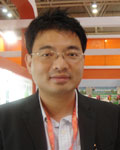|
 |
|
Chen Zi-hong (Zhou Xiaoyan) | Chen Zi-hong has twice attended the annual Cross-Straits Fair for Economy and Trade held in Fuzhou, capital of southeast China's Fujian Province. The fair, starting on May 18 this year, aims to boost trade cooperation, two-way investment and people-to-people exchanges across the Taiwan Straits.
"Last year, we learned a lot from the fair," said Chen, a Taiwanese who founded his own architectural design company in 2006. "I got to meet famous architectural designers, and chatted with students majoring in architecture in Fuzhou and professionals from local designing institutes."
After graduating from the department of architecture at the National ChengKung University in Taiwan in 2001, Chen founded the Cj Chen Architects in 2006. In 2008, he earned a master's degree of science in advanced architectural design after two years at Columbia University in New York.
Chen has participated in many design works, including museums, landscapes, renewal projects, public works, interior design and international competitions. A licensed architect in Taiwan, Chen has become a teacher at National ChengKung University since 2010 and National Taipei University Technology since 2009.
Chen was invited to attend this year's fair, together with several others from Taiwan. His booth was located in the home design exhibition hall.
Most design work in Taiwan focuses on renewal projects or making the building more delicate because land is scarce. The Chinese mainland provides ample opportunities to explore design methods as it undergoes rapid urbanization, said Chen.
"We will put the emphasis of the future development of our company on the mainland and explore the immense designing market starting from Fuzhou. With confidence, a huge market ahead and a good business sense, I'm sure there's a bright future for me and my company on the mainland," said Chen.
He also hopes to promote his own understanding of architectural design on the mainland.
First, he wants to demonstrate Eastern elements and philosophy in his works. "I call it Zen, which means extremely simple, precise and not fancy," said Chen.
Second, he tries to make the building as green as possible to achieve a balance between human beings and buildings, and between buildings and nature. For instance, when designing the building, he would make the best use of natural ventilation to avoid too much use of air conditioning, recycle rainwater for toilet flush and collect solar power for illumination at night. "Within the budget, I want to make buildings as energy-saving as possible," he said.
In Chen's eyes, design is like practicing Chinese kungfu. It's easy to learn fancy moves but hard to improve your internal strength to catch up with those moves. Chen also gave out several tips to his mainland counterparts. Mainland designers have referred to foreign styles but some of them have overlooked a vital concept in architectural design: details.
In Taiwan, after handing out the construction drawings, designers have to follow up through the whole construction process to make sure all details are in line with the original concepts. This is based on thorough communication between designers and builders.
To learn the essence of architectural design of foreign masters, designers need experience. Japanese architectural master Tadao Ando hasn't received any formal education in the field but has great accomplishments. He did it because he traveled a lot. The careful observation of Roman churches makes his work full of light. "My way of experience is similar. I traveled a lot and learned a lot along the way," said Chen.
Email us at: zhouxiaoyan@bjreview.com | 